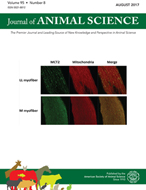-
Views
-
Cite
Cite
S. K. Bhandari, B. Xu, C. M. Nyachoti, D. W. Giesting, D. O. Krause, Evaluation of alternatives to antibiotics using an Escherichia coli K88+ model of piglet diarrhea: Effects on gut microbial ecology, Journal of Animal Science, Volume 86, Issue 4, April 2008, Pages 836–847, https://doi.org/10.2527/jas.2006-822
Close - Share Icon Share
ABSTRACT
Enterotoxigenic Escherichia coli is a major problem in the swine industry and results in scouring, increased mortality, and poor performance in the period immediately postweaning. The traditional way to control this problem is to include subtherapeutic antibiotics in the feed, but this is no longer acceptable to consumers; thus, alternatives to antibiotics are needed. One of the supplements that has been effective in reducing scouring in the absence of antibiotics is animal blood products produced from the rendering process. This is also becoming a problem because of concerns regarding the transfer of transmissible spongiform encephalopathies to humans from animals. In this research, we investigated the effects of spray-dried porcine plasma (SDPP), a Bacillus subtilis direct-fed microbial (DFM), a blend of organic acids, and sweeteners on E. coli-induced scouring. A total of 108 pigs of approximately 17 d of age were assigned to 6 treatments, with 3 pigs per pen, in 2 blocks, with each block having 3 replicates. The 2 blocks were initiated approximately 2 mo apart, because a sufficient number of pigs were not available that met our inclusion criteria in the first block. Diet 1 was a negative control containing no antibiotics (NC). Diet 2 was the positive control and included the same ingredient composition as NC except that antibiotics (110 mg/kg of chlortetracycline, 110 mg/kg of sulfamethazine, and 55 mg/kg of penicillin) were added (PC). Diet 3 was equal to the NC, but with a B. subtilis probiotic (DFM). Diet 4 was the NC to which SDPP was added. Diet 5 was the NC plus a combination of SDPP and DFM (SDPP + DFM). Diet 6 was the NC plus a combination of supplements, including SDPP and a blend of organic acids, DFM, and a sweetener (Blend). At 24 d of age, the pigs were experimentally infected with 6.3 × 109 cfu/mL of E. coli K88. All pigs were euthanized 7 d after infection and tissues were obtained for analysis. There were no significant differences among treatments for ADG, ADFI, G:F, plasma urea nitrogen, α-acid glycoprotein, tumor necrosis factor-α, intestinal ammonia, pH, or VFA. However, the PC and DFM treatments showed decreased (P < 0.05) scours at 24 h postinfection compared with the NC, SDPP, and SDPP + DFM diets. Mortality in the NC treatment, which did not contain antibiotics, was greater (P < 0.05) than in the other treatments. Terminal restriction fragment length polymorphism analysis of the 16S rDNA genes of digesta showed a greater incidence (P < 0.05) of Bacteroidetes in the PC and DFM diets than in the NC diet. When SDPP and DFM were included in the diet, the incidence of Bacteroidetes was also greater than in the NC diet (P < 0.05).





